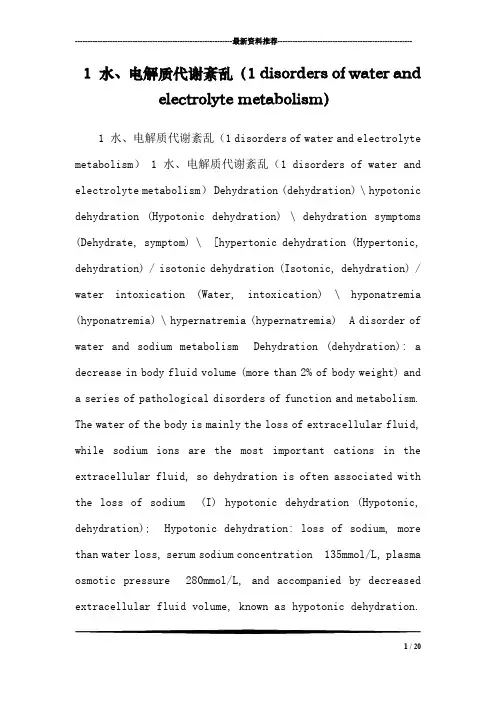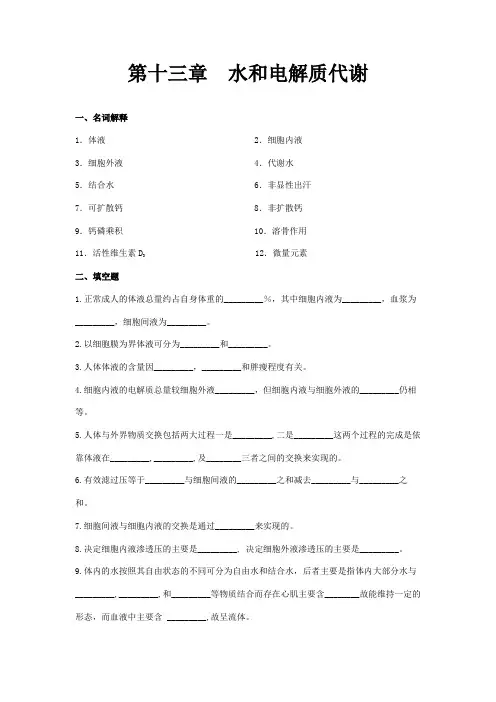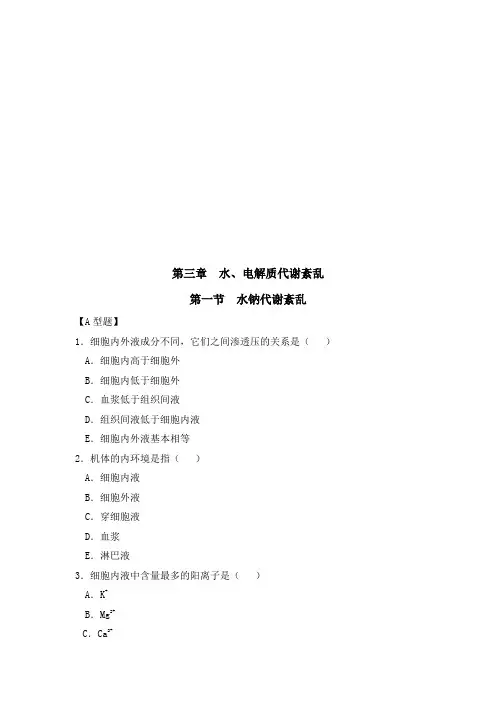第十三章 水和电解质代谢(1)
- 格式:doc
- 大小:96.50 KB
- 文档页数:8




---------------------------------------------------------------最新资料推荐------------------------------------------------------1 水、电解质代谢紊乱(1 disorders of water andelectrolyte metabolism)1 水、电解质代谢紊乱(1 disorders of water and electrolyte metabolism) 1 水、电解质代谢紊乱(1 disorders of water and electrolyte metabolism) Dehydration (dehydration) \ hypotonic dehydration (Hypotonic dehydration) \ dehydration symptoms (Dehydrate, symptom) \ [hypertonic dehydration (Hypertonic, dehydration) / isotonic dehydration (Isotonic, dehydration) / water intoxication (Water, intoxication) \ hyponatremia (hyponatremia) \ hypernatremia (hypernatremia) A disorder of water and sodium metabolism Dehydration (dehydration): a decrease in body fluid volume (more than 2% of body weight) and a series of pathological disorders of function and metabolism. The water of the body is mainly the loss of extracellular fluid, while sodium ions are the most important cations in the extracellular fluid, so dehydration is often associated with the loss of sodium (I) hypotonic dehydration (Hypotonic, dehydration); Hypotonic dehydration: loss of sodium, more than water loss, serum sodium concentration 135mmol/L, plasma osmotic pressure 280mmol/L, and accompanied by decreased extracellular fluid volume, known as hypotonic dehydration.1 / 20Also called hyponatremia of low volume The etiology and pathogenesis of * * * * Mainly the loss of isotonic or hypotonic fluid. 1) extra renal causes A. digestive juices are lost in large amounts, B. fluids accumulate in large amounts in the body cavity, and C. accumulates large amounts of sweat or burns in large areas 2) renal causes A large number of long-term use of sodium intake or natriuretic drug limit A. (hydrochlorothiazide and furosemide and ethacrynic acid etc.)B. chronic renal interstitial disease, ascending limb of Henle and Na with renal dysfunction increased lostC. acute renal failure polyuria period, GFR increase, tubular function did not recover, sodium and water excretion increasedD. salt losing nephritis, tubular epithelial cell lesions of Ald (aldosterone) response to the decrease in sodium reabsorption in renal sodium excretion, reduce excessive The adrenal cortex and e., such as Addison disease, Ald secretion of Na, the decrease in tubular reabsorption and decrease renal sodium excretion and drainage increased F. excessive osmotic diuresis and renal excretion of Na and H2O increase 2. of the impact of the body The basic changes were obvious decrease of extracellular fluid and decrease of osmotic pressure Loss of sodium and water loss, the osmotic pressure of extracellular fluid, the decrease in---------------------------------------------------------------最新资料推荐------------------------------------------------------ extracellular to intracellular water transfer to intracellular water up to cell edema, extracellular fluid decreased more obviously Clinical manifestation 1) circulatory failure (Symptom of, circulatory, failure) The water from the cell to cell outward transfer of extracellular fluid and blood volume down down down down down down, blood pressure, shock 2) dehydration symptoms (Dehydrate, symptom) Lower skin elasticity, sunken socket, and three concave signs in infants.(3) other clinical manifestations (Other, manifestation); - thirsty: early without thirst; in late, there will be thirsty. CNS - symptoms: severe hypotonic dehydration with haziness, drowsiness, coma. - urinary sodium:: urinary sodium or no 10mmol/L. According to the clinical symptoms of the severity of clinical hypotonic dehydration of three degrees (two) hypertonic dehydration (Hypertonic, dehydration); Hypertonic dehydration: dehydration more than sodium loss, serum sodium concentration 145mmol/L, plasma osmotic pressure 310mmol/L, and accompanied by decreased extracellular fluid volume, Hypertonic dehydration. Also called low volume hypernatremia. 1. etiology and pathogenesis Dehydration or loss of low osmotic fluid is the main cause of3 / 20hypertonic dehydration 1) simple dehydration A. is C. through the lung, B. by the skin, and by the kidneys (2) loss of hypotonic fluid C. loss of hypotonic fluid through the gastrointestinal tract, B. profuse sweating, and repeated osmotic diuresis caused by repeated use of mannitol or hypertonic glucose in the a. 2., the impact on the body 1) compensatory response of organism - drink (except for thirst thirst disorder) Plasma osmotic pressure increases, osmoreceptor (+) - (+) - thirsty thirst Here, AGTII relax, thirsty central blood volume (+) - thirsty Hypertonic dehydration, saliva, throat dry down While the proportion of high - oliguria (excluding diabetes insipidus patients) In the water from the cell within the extracellular transfer to the osmotic pressure of extracellular fluid decreased somewhat These three aspects make the extracellular fluid osmotic pressure fall back, so that the early blood volume of dehydration is not easy to drop to the degree of shock 2) the clinical manifestation varies with the degree - urinary sodium Mild hypertonic dehydration (early stage) The osmotic pressure of extracellular fluid, increase blood volume decrease is not obvious, the reabsorption of water and sodium, high urine sodium. Medium and severe hypertonic dehydration---------------------------------------------------------------最新资料推荐------------------------------------------------------ (late) Blood volume and renal blood flow was significantly lower, Ald (aldosterone) secretion, increase urinary sodium down - CNS symptoms Severe hyperosmolar dehydration, intracellular fluid, brain cell dehydration and significantly decrease brain pressure decreases, the severity of the symptoms of CNS - thermal dehydration Here, the body temperature down to increase heat dissipation function, sweat gland secretory cells: liquid - shock, renal failure According to the severity of clinical symptoms, the hypertonic dehydration was three degrees (three) isotonic dehydration (Isotonic, dehydration); Isotonic dehydration: when water and sodium are lost in proportion or after losing fluid, the plasma osmotic pressure is still within normal range, the serum sodium concentration is 135~145mmol/L, and the plasma osmotic pressure is 280~ 310 mmol/L. 1. etiology and pathogenesis Vomiting and diarrhea, a large number of pleural and ascites formation, extensive burns and severe trauma, such as plasma loss. 2., the impact on the body Isotonic dehydration often has clinical manifestations of hypotonic and hypertonic dehydration. A massive loss of isotonic fluid, extracellular fluid, blood volume, blood pressure down, down to the decrease5 / 20in urine volume, body temperature, dehydration obvious appearance Isotonic dehydration can only be converted into hypotonic dehydration if only water is added to the treatment without attention to sodium supplementation. Water intoxication Water intoxication (Water intoxication): when the water intake, over regulating nerve endocrine system and kidney drainage ability, make a lot of water retention in the body, resulting in volume of intracellular fluid and extracellular fluid expansion, and the emergence of a series of diseases including hyponatremia, physical and physiological changes. 1. etiology and pathogenesis 1) take in or enter too much electrolyte free liquid 2) acute or chronic renal insufficiency 3) excessive secretion of ADH Excessive secretion of ADH is defined as abnormal secretion of ADH under certain pathological conditions. (a) ADH abnormal growth syndrome (SIADH): Hypothalamic diseases (encephalitis, brain tumors) and ectopic ADH secretion (lung, oat cell carcinoma) B) other reasons In pain, nausea and emotional stress: relax, ADH secretion of water intoxication In the case of adrenocortical function: GC (glucocorticoid), inhibition of hypothalamic ADH secretion function down down - exogenous ADH input (vasopressin and oxytocin) 4) certain special---------------------------------------------------------------最新资料推荐------------------------------------------------------ pathological states A) heart failure, hepatic ascites, effective circulating blood volume down, down to the water load increase renal drainage and water poisoning (b) hypotonic dehydration - a large amount of electrolyte free water intoxication 2., the impact on the body Prominent manifestation: increased intracellular fluid volume or cell edema When water poisoning occurs, the extracellular fluid increases obviously, and the low permeability of extracellular fluid causes a large amount of water to enter the cell Mild water intoxication, the increase of intracellular and external fluid is not obvious, the symptoms are not obvious, may be weak, dizziness and so on Acute poisoning with water intoxication can cause brain cell edema and increased intracranial pressure, which can be life-threatening test questions 1. the balance of osmotic pressure inside and outside cells mainly depends on the movement of the following substances A., Na+, B., K+, C., Cl-, D., H2O, Ca++, E. 2., a large amount of water is added to the patients with severe hypotonic dehydration, while no sodium salt is added A. hypertonic dehydration, B. isotonic dehydration, C. poisoning, D. hypokalemia, E. edema 3. what are the major characteristics of hypotonic dehydration? 4.7 / 20why is hypertonic dehydration less prone to circulatory failure in the early stage? 5., we compared the similarities and differences between hypotonic dehydration and hypertonic dehydration. Case analysis Male patients, 2 years old, diarrhea 2 days, 6-7 times a day, watery stools; vomiting 3 times, vomiting is the milk consumed, can not eat. Accompanied by thirst, oliguria and bloating. Physical examination: the spirit of malaise, T37oC, BP11.5/6.67KPa (86/50mmHg), skin elasticity, eyes sag, bregmatic subsidence, fast heartbeat and weak, no abnormal lung, abdominal distension, abdominal reflex, decreased bowel sounds, knee reflex, cold extremities. Laboratory tests: serum K+3.3mmol/L, Na+140mmol/L. What kind of water and electrolyte disorder occur in the child? On the basis of what? Comparison of three kinds of dehydration Disturbance of sodium metabolism 1. hyponatremia Hyponatremia (hyponatremia) refers to serum sodium concentrations below 135mol/l. Plasma osmolality mainly depends on the concentration of serum sodium ions, so hyponatremia is usually associated with low osmolarity. (I) hypotonic hyponatremia (hypotonic, hyponatremia): The vast majority of hyponatremia is associated with a decrease in plasma osmolality 1) low capacity hyponatremia (hypovolemic,---------------------------------------------------------------最新资料推荐------------------------------------------------------ hyponatremia) The loss of sodium is more than the loss of water, and the volume of extracellular fluid is decreased, that is, hypotonic dehydration 2) hyponatremia (isovolemic) It is seen in ADH secreting abnormal growth syndrome and osmotic reset 3) high capacity hyponatremia (hypervolemic, hyponatremia) The main causes are congestive heart failure, liver cirrhosis, ascites, nephrotic syndrome and so on, which lead to the pathological changes of the effective circulation and blood loss. Water intoxication (two) isotonic hyponatremia (chronic hyponatremia) (isotonic, hyponatremia); Hyperlipidemia or hyperlipoproteinemia patients, due to the increase of plasma lipid or protein content, serum water proportion decreased, so the serum sodium concentration under normal water, plasma sodium concentration in the clinically measured reduced, then called isotonic hyponatremia. (three) hypertonic hyponatremia (hypertonic, hyponatremia); Hyperosmolar hyponatremia: Sodium by outside impermeable solute permeability caused by increased extracellular fluid pressure increased, the water inside the cells to transfer, extracellular fluid sodium concentration decreases, which leads to the occurrence of hyponatremia in. 2. hypernatremia9 / 20Hypernatremia (hypernatremia): serum sodium concentration is higher than 145mmol/l. With the increase of plasma osmotic pressure, the basic changes of hypernatremia are common when the cells are dehydrated. (I) hyponatremia of low volume Mainly because of the large loss of water or hypotonic fluid, the loss of water exceeds the loss of sodium, which leads to the decrease of extracellular fluid and the increase of serum sodium concentration, which is called hypertonic dehydration (two) hypernatremia with equal capacity It is found in primary hypernatremia, impaired central nervous system and so on (three) hypernatremia with high volume The main reason is the excessive input of sodium solution. In patients who have been rescued from cardiac arrest and respiratory arrest, a large amount of NaHCO3 is added to fight lactic acidosis, resulting in an increase in extracellular fluid volume and sodium concentration. Two 、potassium metabolism disorder Disturbance of potassium metabolism: abnormal changes in K+ concentration in extracellular fluid (especially serum), and the patient’s clinical symptoms and signs depend mainly on the speed and extent of abnormal changes in blood potassium concentration (I) hypokalemia (hypokalemia); When serum potassium concentration is below 3.5mmol/L, it is called---------------------------------------------------------------最新资料推荐------------------------------------------------------ hypokalemia. Potassium depletion: intracellular potassium and loss of total potassium in the body. 1. causes and mechanisms 1) lack of potassium intake 2) excessive potassium loss The loss of potassium through the stomach and intestines (hypokalemia) Loss of kidney by potassium (a) loss of kidney due to increased renal flow at the distal end of the renal tubule A large number of diuretics use: increasing the distal flow velocity of the renal tubule and increasing the exchange of Na with K Renal insufficiency, renal failure (b) aldosterone: aldosterone is the major mineralocorticoid that promotes reabsorption of sodium and the secretion of potassium and hydrogen, causing potassium loss (c) renal tubule transmembrane potential increases negatively, resulting in potassium loss D) loss of potassium caused by low Mg blood Magnesium deficiency in the body, caused by the thick ascending limb of Henle epithelial cell Na, inactivation of the K-ATP enzyme, caused by potassium reabsorption and potassium loss.E) other Type I renal tubular acidosis: obstruction of the distal convoluted tubule to H+ Type II renal tubular acidosis: reabsorption of proximal convoluted tubules in HCO3- Type IV renal tubular acidosis: simultaneous presence of malabsorption11 / 20of Na+ and obstruction of the distal convoluted tubule with H+ Loss of skin by potassium 3) potassium to intracellular transfer (a) alkalosis (b) the use of insulin (c) hypokalemic familial familial periodic paralysis (d) barium poisoning, crude cottonseed oil poisoning 2. effects of hypokalemia on the body Related to the speed, amplitude and duration of blood potassium lowering, the faster the rate of blood potassium lowering, the lower the serum potassium concentration, the greater the impact on the body. 1) the effect on neuromuscular excitability The excitability and conductivity of nerve and muscle tissue are significantly affected Acute hypokalemia, extracellular fluid with constant liquid concentration decreased, intracellular potassium concentration, the results make the intracellular potassium concentration, the ratio of increase of intracellular potassium efflux increased, the absolute value of the resting membrane potential increases, and increase the threshold potential gap, the stimulation threshold excited should also be increased, it caused the excitability of nerve muscle cells decreased. When chronic hypokalemia occurs, the extracellular potassium can be replenished by intracellular potassium, because the potassium concentration in the---------------------------------------------------------------最新资料推荐------------------------------------------------------ extracellular fluid is slowed down, so the symptoms are not obvious. Clinical manifestations: symmetrical limbs, flaccid paralysis, even soft paralysis, paralytic ileus, abdominal distension and so on. Physical examination: reduction of muscle tone in the limbs and decrease or disappearance of tendon reflex. Reason: the excitability of skeletal muscle cells decreases, and the gastrointestinal smooth muscle can also be involved 2) the effect on the heart Mainly cause arrhythmia, severe ventricular fibrillation, leading to heart failure A) physiological changes of myocardium [K +]e decreased, membrane permeability decreased, phase 4 K + efflux decreased, Na + or Ca2 + increased, and autonomic cells automatically increased rapidly and increased automaticity; The reduced membrane permeability decreased [K]e?? Em cell move, Em-Et spacing increased excitability?; The Em shift and Em-Et spacing decrease, the slope of the 0 phase curve increases, the front potential decreases, and the conductivity decreases; The [K +]e decreased 2? Ca2 + influx of [Ca2 +]i increased rapidly accelerated?? myocardial contractility increased (severe and chronic hypokalemia due to intracellular potassium deficiency, affecting cell metabolism, myocardial damage,13 / 20decrease of myocardial contractility). (b) electrocardiographic changes The obvious U wave after S-T segment depression and T wave is characteristic of hypokalemia Conduction prolongation, P-R interval prolongation, ORS wave presentation and broadening The calcium influx in the 2 stage accelerates the potassium efflux, the 2 stage repolarization accelerates and the S-T depression decreases The 3 phase of potassium efflux slowed down to repolarization, and the 3 phase extended to U wave obviously C) arrhythmia In hypokalemia, the myocardial excitability increased, the supernormal period prolonged and the ectopic pacemaker increased automaticity. At the same time, the conductivity decreased, the conduction slow and the effective refractory period shortened, and it was easy to cause excited reentry. Therefore, hypokalemia is prone to premature beats, atrioventricular block, ventricular fibrillation, and other arrhythmias. 3) the influence on acid-base equilibrium Hypokalemia may cause alkalosis (paradoxical uric acid) 4) the effect on the kidney The accumulation of renal dysfunction occurs in the so-called depletion of postassiun (nephropathy) 5) the effect on blood vessels Reducing peripheral vascular resistance to hypokalemia is associated with vertigo, hypotension and other---------------------------------------------------------------最新资料推荐------------------------------------------------------ symptoms 3. prevention and treatment principle of hypokalemia 1) prevention and treatment of primary diseases 2) proper potassium supplementation during treatment. The principle of potassium supplementation: feeding can be taken orally as possible potassium supplement; intravenous potassium supplementation should pay attention to low concentration (20~40 mmol/L) and low flow rate (10 mmol/h); daily potassium supplementation can be controlled at 40~120 mmol. Special attention should be paid to intravenous potassium supplementation only when the renal function is good. When the amount of urine is greater than 500 ml, the potassium supplementation is safe. Potassium deficiency is caused by magnesium deficiency, Magnesium should be supplied before potassium can be effectively supplied. Attention should be paid to the acid-base balance of the patient. (two) hyperkalemia (hyperkalemia); Serum K + concentration greater than 5.5 mmol/L is called hyperkalemia. 1. causes and mechanisms 1) excessive penetration 2) renal excretion of potassium decreased Acute renal failure, oliguria stage, end-stage renal failure. High potassium type distal tubular acidosis Decreased aldosterone secretion or decreased renal15 / 20tubular aldosterone response to aldosterone Long term use of diuretics that can cause potassium retention 3) extracellular release of stromal cells Acidosis A great deal of hemolysis or tissue damage and necrosis When diabetic ketoacidosis occurs Membrane dysfunction of sodium pump Familial familial periodic paralysis of hyperkalemia 2. effects of hyperkalemia on the body 1) the effect on neuromuscular excitability Mild hyperkalemia (5.5 ~ 7.0mmol/L) often results in increased excitability. There are hand foot and foot abnormalities, tremors, myalgia, or colic, and diarrhea; Severe hyperkalemia (7 ~ 9.0mmol/L) often makes the muscle cells appear to be depolarized and blocked, causing muscle paralysis, and clinical weakness of muscle, flaccid paralysis and other symptoms. 2) the effect on the heart The effect on the heart, like hypokalemia, can also cause arrhythmias or ventricular fibrillation, but unlike hyperkalemia, severe hyperkalemia can cause cardiac arrest. (a) characteristics of myocardial physiological changes [K +]e increased, and the permeability of the membrane to K + increased after the repolarization of the self regulatory cells. The 4 phase of K + flow increased, the automatic depolarization slowed down, and the automaticity decreased. Increase of [K +]e, decrease of---------------------------------------------------------------最新资料推荐------------------------------------------------------ Em negative value in cardiac working cells, decrease of Em-Et distance, increase of excitability in mild disease and decrease in severe condition. The Em-Et interval is reduced. In the 0 stage, the depolarization is decreased and the potential is decreased, and the conductivity is decreased. Increase of [K +]e, decrease of calcium influx in 2 stage and decrease in contractility. B) changes in the electrocardiogram The action potential of cardiac myocytes decreased and P wave decreased, widened or disappeared The conductivity decreased, prolonged P-R interval, QRS composite is wide The T wave is high, the Q-T interval shortens and the S-T elevation (c) the manifestation of arrhythmia Acute hyperkalemia is reduced and slow conduction conductivity caused by unidirectional conduction block, and effective refractory period shortened, and also easy to cause the reentry arrhythmia, including ventricular fibrillation. Severe hyperkalemia can result in cardiac arrest due to reduced automaticity, block of conduction, and loss of excitability 3) the influence on acid-base equilibrium Hyperkalemia results in the metastasis of H + to the extracellular region and the decrease of H + in kidney, so metabolic acidosis can occur. (paradoxical alkaline urine) 3.17 / 20prevention and treatment principle of hyperkalemia 1) prevention and treatment of primary diseases 2) reduce blood potassium: myocardial toxicity against high potassium; promote K+ into cells; accelerate K+ excretion Hypokalemia * reasons Insufficient intake of potassium: can not eat or fasting, stomach, parenteral K solution too much: often iatrogenic, such as kidney dysfunction, more rapid, potassium supplementation Potassium loss or discharge excessive vomiting, diarrhea, intestinal fistula; using Paul sodium and osmotic diuresis; renal dysfunction and interstitial renal disease; aldosterone; magnesium deficiency; sweat reduction; renal failure and some kidney diseases; Adrenal cortical insufficiency; potassium sparing diuretic use * k the abnormal distribution of extracellular potassium into the cell: alkalosis; insulin; periodic paralysis; intracellular potassium escape cell barium poisoning: acid poisoning; severe hypoxia; periodic paralysis; hemolysis or serious tissue damage excessive muscle movement; the use of digitalis or propranolol. Effects on the organism * nerve muscle excitability is chronic; varies little Acute: lower chronic: little change Acute: mild increase, severe decrease * cardiac automaticity increases and decreases Excitability increased, slightly increased, decreased when---------------------------------------------------------------最新资料推荐------------------------------------------------------ severe Decreased conductivity Decreased contractility Extend the ECG characteristics of the P-R interval, QRS wave width; S-T segment depression, T wave flat, U wave, Q-T wave, P wave interval prolonged low width, prolonged P-R interval, QRS wave width; S-T elevation, T wave tip The Q-T interval is shortened or normal * clinical presentation, tachycardia, arrhythmia, or ventricular fibrillation, arrhythmia, or cardiac arrest * acid base balance secondary metabolic alkalosis secondary metabolic acidosis * gastrointestinal peristalsis, abdominal distension, paralytic ileus, colic, diarrhea Three, acid-base balance and acid-base balance disorders Under physiological conditions, the pH of the extracellular fluid is between pH37.35-7.45 and the average value is 7.40. Extracellular fluid pH is in this relatively stable state, that is called acid-based (balance), that is, the relative concentration of hydrogen ion concentration ([H+]) in the blood. The maintenance of acid-base balance depends on the humoral buffer system and the mediation of the lungs and kidneys. The acid-base equilibrium disorder refers to various causes accumulation or lack of body acidic or alkaline substances, leading to environmental damage in body fluid acid-base19 / 20homeostasis, which is caused by various reasons of arterial blood [H+] exceeded the normal range (increase or decrease) of the pathological changes.。

第十三章水和电解质代谢一、选择题【单选题】1.体液的组成成分是A. 水、无机盐、核酸B. 水、无机盐、糖C. 水、无机盐、脂类D. 水、无机盐、低分子有机物和蛋白质E. 以上都不是2.体液量最多的是A. 细胞内液B. 细胞外液C. 血浆D. 淋巴液E. 组织间液3.新生儿含水量约为A. 60%B. 50%C. 75%D. 80%E. 65%4.关于水的含量在个体间的差异,下列哪项是错误的A. 成人多,老年人少B. 胖者多,瘦者少C. 婴儿多,成人少D. 男性多,女性少E. 瘦者多,胖者少5.细胞内液的主要阳离子是A. 钠离子B. 镁离子C. 钾离子D. 钙离子E. 锰离子6.细胞外液的主要阳离子是A. 钠离子B. 钾离子C. 钙离子D. 镁离子E. 锰离子7.细胞内外渗透压的平衡主要是靠哪种物质的移动A. 钠离子B. 钾离子C. 葡萄糖D. 蛋白质E. 水8.细胞外液的主要阴离子是A. HCO3-B. Cl-C. HPO42-D. Pr-E. SO42-9.按摩尔电荷浓度计算,细胞内液电解质总量高于细胞外液,因此渗透压A. 细胞内液大于细胞外液B. 细胞外液大于细胞内液C. 细胞内液与细胞外液基本相等D. 细胞内液大于组织间液E. 以上都不是10.血浆与组织间液的重要差别是A. 渗透压不同B. 钾离子不同C. 钠离子不同D. 蛋白质含量不同E. 以上都不对11.有关水的功能错误的是A. 调解体温B. 运输物质C. 防御作用D. 润滑作用E. 促进、参与化学反应12.各种消化液体丢失后,共同缺乏的电解质是A. 钠离子B. 钾离子C. 氯离子D. 碳酸氢根离子E. 钙离子13.成人每日最低需水量为A. 1000mlB. 1500mlC. 2000mlD. 2500mlE. 500ml14.正常成年人每日尿量约为A. 500mlB. 1000mlC. 1500mlD. 2000mlE. 2500ml15.人体每日最少尿量为A. 2500mlB. 500mlC. 1500mlD. 350mlE. 150ml16.不能进食的人每日最低补液量为A. 2500mlB. 500mlC. 1500mlD. 350mlE. 100ml17.既能增强神经肌肉的兴奋性又能降低心肌兴奋性的离子是A. Ca2+B. Mg2+C. Cl-D. OH-E. K+18.对ADH的描述,下列哪项是正确的A. 促进肾远曲小管分泌H+,重吸收Na+B. 促进肾远曲小管排K+,重吸收Na+C. 促进肾远曲小管和集合管对水的重吸收D. 促进远曲小管对K+的吸收E. 以上都不对19.对于醛固酮的描述正确的是A. 促进肾远曲小管对K+的重吸收B. 它是由肾上腺髓质分泌的C. 属于含氮类激素D. 促进肾远曲小管分泌H+, 排K+, 重吸收Na+E. 以上都不对20.一次摄入大量水分后,尿量增加是由于A. ADH分泌减少B. ADH分泌增加C. ADH分泌不变D. 与ADH分泌无关E. 以上都不对21.大量出汗可出现A. 低渗性脱水B. 高渗性脱水C. 等渗性脱水D. 水中毒E. 以上都不对22.影响ADH分泌的因素有A. 血浆渗透压B. 血容量C. 血压D. 精神因素E. 以上都是23.下列哪一种情况不引起ADH分泌增加A. 缺水B. 大量饮水C. 血容量减少D. 血浆渗透压升高E. 血压下降24.直接刺激肾上腺皮质球状带细胞分泌醛固酮的是A. 肾素B. 血管紧张素ⅠC. 血管紧张素ⅡD. 血管紧张素原E. 血容量减少25.下列关于肾脏对钾排泄的叙述哪一项是错误的A. 多吃多排B. 少吃少排C. 不吃不排D. 不吃也排E. 吃得少,排的少26.下列能引起血钾浓度降低的是A. 创伤B. 高烧C. 饥饿D. 呕吐E. 缺氧27.醛固酮分泌减少导致A. 血K+浓度降低B. 血Na+浓度增高C. 血HCO3-浓度升高D. 尿PH升高E. 血容量升高28.有关钙的叙述错误的是A. 降低神经肌肉的兴奋性B. 降低心肌的兴奋性C. 降低毛细血管的通透性D. 参与血液凝固E. 构成骨与齿29.血钙增高可引起A. 心率减慢B. 心肌兴奋性增强C. 骨骼肌兴奋性增强D. 抽搐E. 以上都不对30.当给病人注射胰岛素和葡萄糖以后,体内钾代谢的变化是A. 无变化B. 细胞外钾进入细胞C. 细胞内钾出细胞D. 尿钾增多E. 血钾增多31.一慢性肾功能衰竭患者有酸中毒表现,在补充碳酸氢钠液体时,患者出现手足搐搦,此时应补充的电解质是A. Na+B. K+C. Ca2+D. Mg2+E. H+32. 一两岁幼儿有睡眠不安、好哭、易出汗等现象,且有方颅、囟门闭合晚、站立时两腿呈“X”型,该患儿最可能的病因是缺乏A. 钙B. 钾C. 锌D. 维生素DE. 铁33.细胞内液约占体重A.5%B.15%C.20%D.40%E.60%34.体液总量约占体重A.5%B.15%C.20%D.40%E.60%35.细胞外液约占体重A.5%B.15%C.20%D.40%E.60%36.血浆约占体重A.5%B.15%C.20%D.40%E.60%37.细胞间液约占体重A.5%B.15%C.20%D.40%E.60%38.血清浓度为3.5—5.5mmol/L的离子是A.Na+B.Cl-C.K+D.HPO42-E.Ca2+39.细胞内液的主要阴离子A.Na+B.Cl-C.K+D.HPO42-E.Ca2+40.降低神经肌肉兴奋性的是A.Na+B.Cl-C.K+D.HPO42-E.Ca2+【多选题】41.体液中电解质分布和含量的特点是A.各体液中正负离子总量相等(以mEq/l计)B.细胞内外液电解质组成有很大差异C.细胞内液电解质总量高于细胞外液D.细胞内外液渗透压相等E.细胞内液渗透压高于细胞外液42.水的功能是A. 促进化学反应B. 运输物质C. 调节体温D. 润滑作用E. 维持体液的酸碱平衡43.使醛固酮分泌增加的是A. 血钾升高B. 血钾降低C. 血钠下降D. 血钠升高E. 血钙升高44.引起ADH分泌增加的是A. 血浆渗透压升高B. 血容量降低C. 血压降低D. 精神紧张E. 血钾升高45.在高血钾时,心脏可发生A. 心动过速B. 心动过慢C. 心脏停止于收缩期D. 心脏停止于舒张期E. 心肌收缩加强二、名词解释1. 体液2. 每天必然丢失水量3. 高渗性脱水4. 血浆有效胶体渗透压5. 成骨作用三、填空题1. 正常成人体液总含量约占体重的 , 其中细胞内液占体重的,细胞外液占体重的,血浆占体重的,细胞间液占体重的。

第十三章水和电解质代谢一、名词解释1.体液 2.细胞内液3.细胞外液 4.代谢水5.结合水 6.非显性出汗7.可扩散钙 8.非扩散钙9.钙磷乘积 10.溶骨作用11.活性维生素D3 12.微量元素二、填空题1.正常成人的体液总量约占自身体重的_________%,其中细胞内液为_________,血浆为_________,细胞间液为_________。
2.以细胞膜为界体液可分为_________和_________。
3.人体体液的含量因_________,_________和胖瘦程度有关。
4.细胞内液的电解质总量较细胞外液_________,但细胞内液与细胞外液的_________仍相等。
5.人体与外界物质交换包括两大过程一是_________,二是_________这两个过程的完成是依靠体液在_________,_________,及________三者之间的交换来实现的。
6.有效滤过压等于_________与细胞间液的_________之和减去_________与_________之和。
7.细胞间液与细胞内液的交换是通过_________来实现的。
8.决定细胞内液渗透压的主要是_________, 决定细胞外液渗透压的主要是_________。
9.体内的水按照其自由状态的不同可分为自由水和结合水,后者主要是指体内大部分水与_________,_________,和_________等物质结合而存在心肌主要含________故能维持一定的形态,而血液中主要含 _________,故呈流体。
10.正常成人每日水的进出量大致相等,约为________毫升, 每日尿量约为_________ 毫升,最低尿量不能低于_________毫升, 否则视为少尿,造成尿毒症。
11.每克糖完全氧化时产生水_________ml, 每克脂肪完全氧化时产生水_________ml, 每克蛋白质彻底氧化产生水_________ml,混合膳食情况下,成人每日“代谢水”的产量约为_________ml。





第三章水、电解质代谢紊乱第一节水钠代谢紊乱【A型题】1.细胞内外液成分不同,它们之间渗透压的关系是() A.细胞内高于细胞外B.细胞内低于细胞外C.血浆低于组织间液D.组织间液低于细胞内液E.细胞内外液基本相等2.机体的内环境是指()A.细胞内液B.细胞外液C.穿细胞液D.血浆E.淋巴液3.细胞内液中含量最多的阳离子是()A.K+B.Mg2+C.Ca2+D.Na+E.Fe2+4.机体通过下述哪项的移动来维持细胞内外渗透压的平衡()A.Na+B.葡萄糖C.K+D.水E.蛋白质5.低容量性的低钠血症特征是()A.失水多于失钠B.血清钠浓度<130mmol/LC.血浆渗透压<310mmol/LD.伴有或不伴有细胞外液量减少E.细胞内液量减少6.决定脱水类型的因素为()A.体液总量B.细胞内液渗透压C.细胞外液渗透压D.血浆胶体渗透压E.组织间液胶体渗透压7.正常机体内水和电解质的动态平衡主要通过下列哪项来调节() A.神经系统B.血浆渗透压C.胃肠道D.神经内分泌系统E.内分泌系统8.何种类型的水与电解质失衡最易发生外周循环衰竭()A.低容量性高钠血症B.低容量性低钠血症C.等渗性脱水D.高容量性低钠血症E.水肿9.调节钠水平衡的主要器官是()A.皮肤B.肺C.胃肠D.肾E.汗腺10.低容量性低钠血症最主要的原因是()A.长期连续使用高效利尿剂B.醛固酮分泌不足C.肾小管酸中毒D.消化道大量失液E.大量失液后处理不当11.最易发生脱水热的水与电解质紊乱类型是() A.低容量性高钠血症B.低容量性低钠血症C.等渗性脱水D.水肿E.高容量性低钠血症12.低容量性低钠血症体液丢失最严重的部位是() A.细胞内液B.组织间液C.血浆D.淋巴液E.第三间隙液13.低渗性脱水的突出特点是()A.明显口渴B.ADH分泌增多C.易发生休克D.早期尿量减少E.细胞内液显著减少14.下列哪种情况属于低容量性低钠血症()A.主要是细胞内脱水B.口渴明显C.失水大于失钠D.囟门、眼窝塌陷,外周循环衰竭较早出现E.早期尿量减少15.低渗性脱水时尿钠减少的主要原因是()A.交感-肾上腺髓质系统兴奋B.肾素-血管紧张素-醛固酮系统兴奋C.肾素-血管紧张素-醛固酮系统抑制D.交感-肾上腺髓质系统抑制E.以上都不对16.低渗性脱水早期尿量和尿比重的变化是()A.尿量减少,尿比重增高B.尿量增加,尿比重降低C.尿量增加,尿比重增高D.尿量减少,尿比重降低E.尿量增加,尿比重无变化17.下列哪一类水、电解质紊乱最容易发生外周循环衰竭()A.低渗性脱水B.高渗性脱水C.等渗性脱水D.水中毒E.等容性低钠血症18.一小儿严重腹泻,只补充葡萄糖溶液,最易引起何种水与电解质平衡紊乱()A.低容量性高钠血症B.水肿C.低容量性低钠血症D.低钙血症E.高容量性低钠血症19.低容量性低钠血症时体液分布改变的特点()A.细胞内液无丢失,仅丢失细胞外液B.细胞内液无丢失,仅丢失血浆C.细胞内液无丢失,仅丢失组织间液D.细胞外液无丢失,仅丢失细胞内液E.细胞内外液均明显丢失20.临床上对伴有细胞外液减少的低钠血症一般首先应用()A.高渗氯化钠B.10%葡萄糖液C.低渗氯化钠D.50%葡萄糖液E.等渗氯化钠21.严重呕吐、腹泻患儿有皮肤弹性降低,眼窝凹陷,前囟下陷,这主要是() A.血容量减少B.细胞内液减少C.低钾血症D.低钠血症E.细胞外液减少22.低容量性高钠血症患者最早出现的表现()A.外周循环衰竭B.尿钠减少C.血清钾浓度降低D.口渴E.细胞内液量增多23.哪种类型的水、电解质平衡紊乱可导致颅内出血()A.低容量性高钠血症B.低钠血症C.高钾血症D.高钙血症E.高镁血症24.极度衰弱的病人易产生()A.低容量性高钠血症B.低容量性低钠血症C.等渗性脱水D.高容量性低钠血症E.低钠血症25.下列哪项在低容量性高钠血症时不容易发生()A.少尿B.口渴C.脱水热D.休克E.尿比重高26.某病人反复呕吐、腹泻伴高热2天,最易发生何种水与电解质代谢紊乱() A.低容量性高钠血症B.等渗性脱水C.低容量性低钠血症D.高容量性低钠血症E.水肿27.低容量性高钠血症时体液分布改变的特点()A.细胞内外液均减少,但以细胞内液减少为主B.细胞内外液均减少,以细胞外液减少更明显C.细胞内液无丢失,仅丢失血浆D.细胞内液无丢失,仅丢失组织间液E.细胞内外液均明显减少28.高热患者不作任何处理,易发生()A.低容量性高钠血症B.低容量性低钠血症C.等渗性脱水D.高容量性低钠血症E.水肿29.低容量性高钠血症的特征下列哪项是错误的() A.失水多于失钠B.血清Na+浓度>150mmol/LC.血浆渗透压>310mmol/LD.细胞外液量减少E.细胞内液量增多30.高渗性脱水时体液丢失的特点是()A.细胞内外液均明显减少B.细胞外液减少,细胞内液无变化C.细胞外液减少,细胞内液增多D.细胞内外液均减少,但细胞外液减少更明显E.细胞内外液均减少,但细胞内液减少更明显31.高渗性脱水早期尿钠浓度增高的原因是()A.醛固酮分泌增多B.醛固酮分泌减少C.体内钠浓度相对增加D.肾小管重吸收水增多E.氢-钠交换减少32.下列哪一类水、电解质紊乱可导致脱水热() A.低渗性脱水B.高渗性脱水C.等渗性脱水D.水中毒E.低钠血症33.尿崩症患者易出现()A.高渗性脱水B.低渗性脱水C.等渗性脱水D.水中毒E.低钠血症34.代谢性酸中毒时过度通气可产生()A.水肿B.水中毒C.低渗性脱水D.等渗性脱水E.高渗性脱水35.伴有细胞外液减少的高钠血症也可称为() A.原发性脱水B.高渗性脱水C.等渗性脱水D.低渗性脱水E.慢性水中毒36.急性肾功能衰竭少尿期摄入水过多可发生() A.高渗性脱水B.低渗性脱水C.等渗性脱水D.水中毒E.水肿37.水中毒时体液的流动趋势是()A.由细胞外至细胞内B.由细胞内至细胞外C.由组织间隙至血管内D.由血管内至淋巴管内E.由血管内至组织间隙38.高容量性低钠血症最大的危险是()A.循环功能障碍B.肾功能衰竭C.血液稀释D.中枢神经系统功能障碍E.凹陷性水肿39.下列哪一种情况的早期就出现神经精神症状() A.高渗性脱水B.低渗性脱水C.等渗性脱水D.急性水中毒E.慢性水中毒40.等容量性低钠血症原因是()A.ADH分泌异常增多B.ADH分泌减少C.肾素分泌增多D.肾素分泌减少E.心房肽分泌增多41.高容量性低钠血症时体液容量表现为()细胞内液组织间液血浆A.↑↓↓B.↑↑↑C.明显↑↑↑D.↑比血浆↑更明显↑E.↑↓↑【B型题】题42~43口渴脱水症外周循环衰竭A.明显明显早期轻症无B.明显无早期轻症无C.早期轻症无明显早期可发生D.早期轻症无无早期可发生E.明显无早期可发生42.低容量性高钠血症(高渗性脱水)时()43.低容量性低钠血症(低渗性脱水)时()题44~45尿量尿钠含量A.正常↓B.↑正常C.↓正常D.↓↓E.↓↑44.低容量性高钠血症(高渗性脱水)早期()45.低容量性低钠血症(低渗性脱水)早期()题46~48A.高渗性脱水B.等渗性脱水C.低渗性脱水D.水中毒E.盐中毒综合症46.伴有细胞外液减少的低钠血症见于()47.伴有细胞外液增多的低钠血症见于()48.伴有细胞外液减少的高钠血症见于()题49~52A.低渗性脱水B.等渗性脱水C.高渗性脱水D.低钠血症E.高钠血症49.昏迷患者易出现()50.大汗后易出现()51.尿崩症患者易出现()52.腹泻后只饮水易出现()题53~56A.尿量减少而尿钠偏高B.尿量减少而尿钠降低C.尿量增加而尿钠偏高D.尿量增加而尿钠正常E.尿量不减少而尿钠降低53.低容量性高钠血症早期()54.低容量性高钠血症晚期()55.肾外原因引起的低容量性低钠血症早期()56.肾性原因引起的低容量性低钠血症晚期()【C型题】题57~59A.细胞外液减少B.细胞内液增多C.两者均有D.两者均无57.高容量性低钠血症()58.低容量性高钠血症()59.低容量性低钠血症()题60~62A.易发生外周循环衰竭B.明显口渴、少尿C.两者均有D.两者均无60.低容量性低钠血症()61.低容量性高钠血症()62.等渗性脱水()题63~66A.少尿、脱水症B.在婴儿可出现脱水症C.两者均有D.两者均无63.低容量性高钠血症()64.低容量性低钠血症()65.急性高容量性低钠血症()66.等渗性脱水()题67~69A.脱水症B.外周循环衰竭C.两者均有D.两者均无67.低容量性高钠血症早期()68.低容量性低钠血症早期()69.重度等渗性脱水()【X型题】70.溶液的渗透压决定于()A.溶质的种类B.溶质的分子量C.溶质分子的数目D.溶质分子的大小E.溶液的多少71.决定细胞膜跨膜水流方向的离子有()A.Cl-B.K+-C.HCO3D.Na+2-E.HPO472.促进醛固酮分泌的因素有()A.血管紧张素ⅠB.血管紧张素ⅡC.血管紧张素ⅢD.低钠血症E.低钾血症73.促进抗利尿激素释放的主要刺激是()A.血管紧张素Ⅱ减少B.血浆晶体渗透压增高C.循环血量减少D.血糖降低E.血浆蛋白浓度74.下列哪些情况可以引起高渗性脱水()A.昏迷B.频繁呕吐C.高热D.尿崩症E.大面积烧伤75.低容量性低钠血症早期的临床表现有()A.多尿B.口渴C.脉细速D.低比重尿E.血压下降76.重度低渗性脱水患者临床上可出现()A.表情淡漠B.明显脱水症C.休克D.血压下降E.少尿77.高容量性低钠血症可出现()A.血清钠浓度>150mmol/LB.血容量增高C.中枢神经系统功能障碍D.细胞脱水E.细胞外液渗透压增高78.水中毒时可出现()A.细胞外液增多B.血钠浓度增高C.颅压增高D.细胞水肿E.血液稀释79.炎热夏天大量出汗又无水喝可能发生的水、电解质代谢紊乱有()A.高渗性脱水B.低钾血症C.高镁血症D.休克E.细胞脱水80.下列哪些符合低容量性低钠血症的特征()A.失水大于失钠B.细胞外液减少C.细胞内液增加D.血清Na+浓度小于140mmol/LE.血浆渗透压小于280mmol/L81.下列哪些水、电解质紊乱能引起颅内出血()A.高容量性高钠血症B.高容量性低钠血症C.低容量性低钠血症D.等容量性高钠血症E.等容量性低钠血症82.下列哪些情况可以引起等渗性脱水()A.小肠梗阻B.出汗过多C.大面积烧伤D.高热E.抽放大量腹水83.高渗性脱水早期,机体的代偿反应表现为()A.口渴中枢兴奋B.ADH释放增多C.醛固酮分泌增加D.细胞内水分转向细胞外E.细胞外水分转向细胞内【判断题】84.低容量性低钠血症(又称低渗性脱水)的主要特点是失水多于失钠。